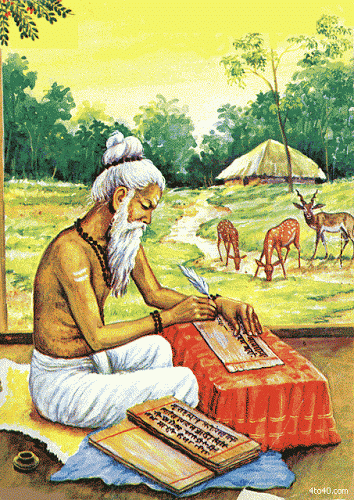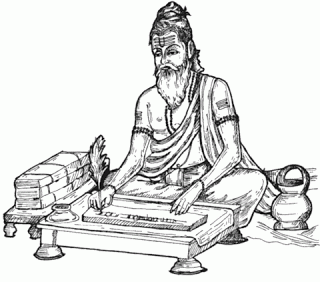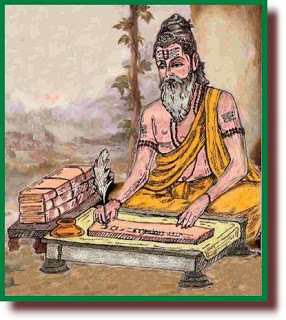
Sangam Tamil Literature has several poets with Sanskrit names. Mostly they are Hindu God names. The British rulers who followed the policy of divide and rule coined some artificial words like Dravidian and Aryan. Of these two words Aryan is known from the days of Rig Veda and Dravidian from very late stages of Indian literary history. But both the words had no racial meaning in which the scholars use them today. The scholars only have given them racial connotation. Because of this distorted picture, everything in history was written with a bias. But those who read Sanskrit and Tamil literature will find more similarities than differences in the Indian culture.
Every country, every culture has regional differences which are normal and superficial. There is no place in the world without such differences. Tamils of ancient Tamil Nadu had so many differences in the five different land divisions known as Kurinji, Mullai, Marutham, Neithal and Palai. These were natural. The three kingdoms fought among themselves for 2000 years without stopping. But nobody interpreted them as enemies of one race or another.
Hindu customs, Sanskrit words, Hindu Gods, Sanskrit proper names are in every ancient Tamil book. Kanchi Paramacharya has pointed out the unity in thought beautifully well in one of his lectures. He pointed out that there are very pure Tamil words for all the Sanskrit words from very ancient times : (Yagam= Velvi, Brahmin=Anthanar, Veda= Marai, River Jamuna= Thozunai etc.). So there is no wonder that there were poets with Sanskrit names in ancient Tamil Nadu. I have pointed out that Brahmins contributed one third of Sangam Literature in my post ‘’NO BRAHMINS, NO TAMIL’’.
Sanskrit names found in the Sangam Tamil literature sound very interesting. When they give the name of a Brahmin poet they give the Gotra name as well. We can understand the reason for it. Same name is used by many poets and to differentiate them either town name or the Gotra name was used.

Following are some of the SANSKRIT names of Tamil Poets:
Damodaran, Kesavan, Vishnu Dasan (Vinnanthayan), Kamakshi (Kamak Kanni), Maha Devan (Maathevanar), Kausika (Kosikan), Kapila (very pouplar Rishi’s name), Parana (Parana is a Gotra name),Nagaraja (Mudinaagaraayar),Maha Sastha (Maasaaththan), Lochana(ulochanar), Bhutapandya, Krishna (Kannan), Arudra (Aththirai), Kumara (kumaranar), Gauthama (Gothamanar), Sanga Varunan, Rudra (Nalluruththiranar), Nagas (at least 20 names with Naga as surname)Brahma (piramanar), Brahma Dutt ( Yaz piramathaththan), Uthra (Uththiraiyar), Maha Chitra (perumsiththiranar), Maha Padma (perumpathumanar), Atreya, Kavya (kappiynaar) Yagna Acharya (Velaasaan), Beri Sastha. (This is not an exhaustive list. This is only a sample. More in my post ‘’No Brahmins, No Tamil’’.
Tamil kings performed Rajasuya, Asvamedha and Soamyaga (Avvaiyar attended the Rajasuya Yagna and praised the Tamil unity which was very rare. Kalidasa praised Pandyan king’s (probably Mudukudumi Peru Vazuthi’s ) Asvamedha Yangna indirectly by referring to Avabrudha Snana. Peruvazuthi coins have been discovered with Yupa pillar and horse/Asva.
Tamil Epic Silappadikaram has Gopalan (Kovalan), Madhavi, Maha Nayak (Maanayakan), Maha Shastha (Maasaaththan),Parasaran, Dakshinamoorthy etc.
Of these names, the word Valmiki (written as Vanmeekanar) raised the eye brows of many a scholar. The most famous Valmiki was the author of Ramayana in Sanskrit. From Sanskrit poet Kalidas to Tamil poet Kamban, all praised him as the Adi Kavi (meaning the original poet, the first poet). He gave the most interesting epic Ramayana in the simplest language. Many people learnt Sanskrit just by studying Valmiki Ramayana.
Hindus knew the story of original Valmiki- the robber turned poet-saint. The best example for the English saying ‘’every sinner has a future and every saint had a past’’. But who is this Tamil Valmiki (Vanmeekan) mentioned in the oldest part of Sangam literature? He was the author of verse 358 in Pura Nanauru which is a collection of 400 verses. Purananuru is like an encyclopaedia of Tamil culture. We knew a lot about the Tamil life 2000 years ago through the commentaries on the 400 verses (a few verses were lost).
Who was Tamil Valmiki?
Vanmikam in Sanskrit means ant hill. This robber turned saint did penance for a long time and ant hill grew over him and he got the name Valmiki. His original name was Prachedas. We have this name associated with several saints with the same experience of long penance and ants building a hill over them. Gods in several Shiva temples had his name in Tamil Nadu. Vanmeekanathar is found in Tiruvarur, Sankarankoil, Kudavasal, Kancheepuram, Thiruvetriyur and Valmiki Samadhi (grave) in Ettukkudi. Every temple had its own story of that particular Valmiki. Slowly priests and tourist guides or Sthala Puranas (Local Temple History) identified them with the most famous Valmiki.
My research shows that Valmiki was a Gotra (clan) name like Agastya, Kausika, Kavya, Atreya and other seers. Research scholars report 20+ Vyasas, 6 Avvaiyars, 2 or 3 Kapilas, Paranas etc. It is not uncommon. We find kings names in plenty like Ramses, Alexander, Vikramaditya, Rajendra, Ptolemy, Sri Maran, Veera Pandya, Vikrama Pandya. These names were repeated umpteen times in history.

Valmiki Gotra
The following note was copied by me on 5[SUP]th[/SUP] May 2002 from the book ‘’Retrieval of History from Puranic Myths’’ by P.L.Bhargava (available at SOAS Library, University of London):
“Pravaradhyaya of the ancient Baudhayana Srauta Sutra (800 to 400 BC) mentions Valmiki as a Gotra in the Vatsa Paksha of the family of Bhrgu. This name thus could be borne by other persons of this gotra and this is proved by the fact that we learn from the Taitriya Pratisakhya of a Phoenician Valmiki who was different from the famous poet Valmiki.’’
So I think the author of Puram 358 verse was a seer cum poet of this Gotra. He was very religious and he praised penance sky high. Penance or ascetic life is greater than house holder’s life. He adds that Goddess Sri (Lakshmi) always stays with those who sacrificed everything. She would not stick to those who have desires. The wealth he is talking about is the spiritual wealth. Talking about the impermanence of the world, he said that this earth had seven kings within a single day.
The name Valmiki always commands respect. Now the riddle of Tamil Valmiki is solved.
